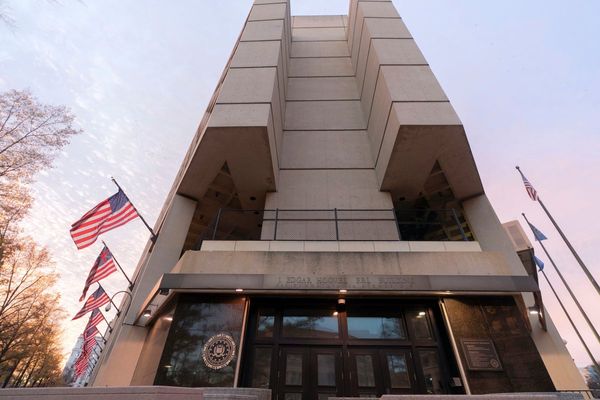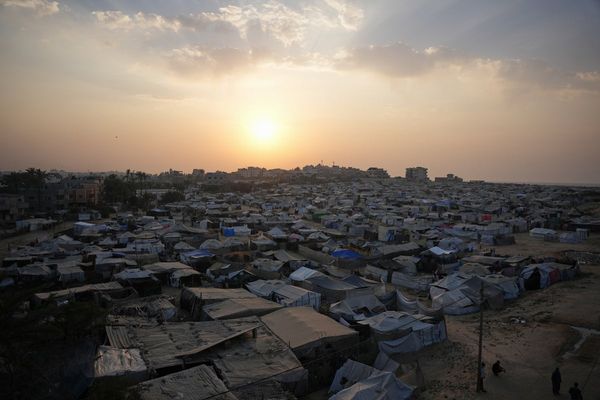
Energized from a hearty meal, kids giggle and chase after one another in the courtyard as their parents and relatives sit by the family house, chit-chatting about the year that has gone by. At night, they light up packs of sparklers together, with colored flames flickering on their smiling faces.
Wang Liang, a Taiwanese artist based in Toronto, vividly recalls the scene from childhood during the Lunar New Year holidays in Taiwan. It has become one of the many sources of inspiration that helps him forge bonds with his hometown after living most of his life abroad.
Last year, Wang painted a mural of a ponytailed girl holding a sparkler on a sanheyuan wall in the rural town of Tianwei after returning to Taiwan several months into the pandemic. The girl’s face glows with joy as the lights cast a warm hue on her clothes and in the room.
The work is based on a photo of his cousin, but it represents one of his long-lasting impressions of Taiwan as a child, he said. “The head of the painting village gave me this wall. He thinks the mural makes the residential compound feel like home.”

Many villages in Taiwan have become blanketed in colorful street art over the past few years to attract urban tourists and revive the economy, including Tianwei’s Haifonglun. At the invitation of the head of the project, Wang, hoping to build a career in public art, agreed to create his first artwork in Taiwan at the village. “Because of this artwork, I got to stay in Tianwei for around a week, visiting places I’ve never been and seeing things I’ve never seen before,” he said.
Quest for connection
Wang, 29, left Taiwan at the age of five with his parents, joining many other families that moved to China in the 1990s when China opened its door to foreign investment and Taiwan began allowing companies to invest in its neighbor to the west. The artist remembers growing up being surrounded by classmates inquisitive about his roots on the other side of the strait.
Despite settling down in China, Wang and his family made it a routine to return to Taiwan every year for vacations and Lunar New Year celebrations before moving to Australia for his high school education. “I would feel relieved to come back,” he said. “Most in our extended family are still in Taiwan, so there are still ties.”
For young Wang, Taiwan symbolized fun and excitement. Living in the suburbs of Huizhou, he seldom hung out with his friends outside of class. His life used to be largely confined to his home, a dormitory for Taiwanese management for factories at a massive industrial park, and his school, which either he commuted to by bus or by rides from his parents. Wang’s parents would only take him to the downtown for dinner or shopping. But in Taiwan, he could take a trip around the island, rub shoulders at night markets, or play video games with his cousins at home.
After around ten years in China and two years in Australia, Wang took up residence in Canada to be trained as a painter. Three years ago, his first solo exhibition One day I saw the sunset forty-four times featured a series of paintings in Toronto, but the artist had longed to create a portfolio of work about the beauty of Taiwan. The pandemic, which brought him back home in summer, affords an opportunity for exploration. “This has been the longest time I’ve stayed in Taiwan since moving to China,” he said. “I’ve never had a life in Taiwan, and I’d like to understand what it’s like.”
For his show in Taiwan, he traveled to cities and towns he had never set foot upon, on the lookout for images characterizing the people and their surroundings in the place he had come to feel, in some sense, that he had never left. A traditional wet market, houses standing neatly by an irrigated field, and a blue truck that crawls along meandering paths across the island. He rendered most of them in a form of water color, gouache, on paper to be displayed at Kaohsiung’s Arcade Art Gallery in mid May. The majority of these works have been sold during the show, despite being disrupted by an outbreak of Covid-19.

For the series of work for Never Left, the artist has also drawn inspiration from his memory of Taiwan as a child. Before painting The Alley at Grandma’s Place, he revisited Sanchong and recalled how a neighbor several years older taught him to ride a bicycle in the alley in front of his grandmother’s apartment. “I hope painting lovers in Taiwan can feel what I feel about Taiwan and their connections with their home,” he said.
Art for greater impact
Despite his familiarity with paper and canvas, Wang has sought to establish himself as a mural artist over the last two years, which he believes will enable him to make a greater impact with his work. This art form “does not exist for individual art collectors,” he said. “If you draw on a wall, then everyone can see it.” When the Covid-19 outbreak partially shut down his show, Wang finished a mural on a white wall at the gallery, depicting a ship sailing toward the port of Kaohsiung.
In Taiwan, the development of public art is at its nascent stage, but Wang said he has seen generous support for this form of art in Canada and the United States, which hosts mural festivals across the country. He hopes his diving into the new field will encourage other Taiwanese artists to follow in his footsteps.
Weiwuying Street Art Village, five metro stops from the Arcade Art Gallery, stood out as one of Taiwan’s most successful attempts to introduce art into urban environments. Over the course of five years, local and international artists, including Okuda San Miguel from Spain and Sen2 from New York, have turned the former military barracks into an open art gallery.
In October, Wang painted a wall of a four-story apartment building facing the streets at Weiwuying. New to mural art, he described being a little “intimidated” when the gallery offered him the opportunity.

Painting over a high wall is a challenging task, but for the artist, it also turned out to be a gratifying experience. “When I was painting their building, a resident surnamed Chen said ‘Hi!’ to me from the balcony and handed me bread and beverage. And I often had lunch at the noodle stall downstairs owned by another resident. While creating the art, I had a lot of interactions with local people and I felt warm inside.”
Wang named the work Standing Tall. At the mural’s center is a rose standing upright, its leaves shooting outward. He said the idea for the mural came from Antoine de Saint-Exupéry’s Le Petit Prince. “Growing up, I’ve moved from one place to another as the prince in the story,” he said. “While I’m fortunate enough to have returned to Taiwan, I imagine the prince has also returned to his planet and met with his rose.”
READ NEXT: A Yutori Dystopia: Izumi Suzuki’s ‘Terminal Boredom’
TNL Editors: Nicholas Haggerty (@thenewslensintl)
If you enjoyed this article and want to receive more story updates in your news feed, please be sure to follow our Facebook.







